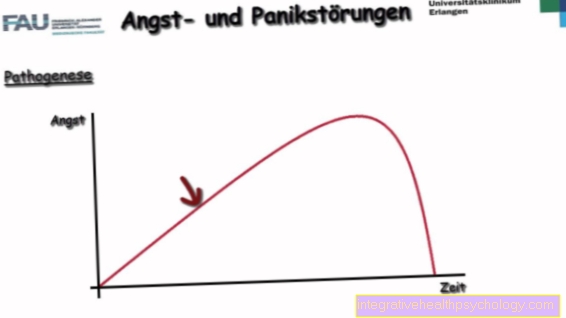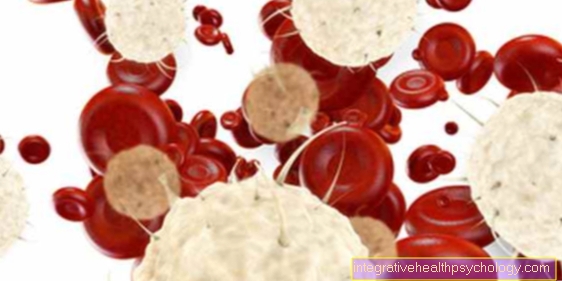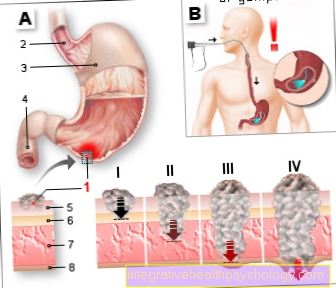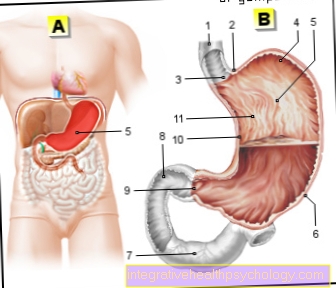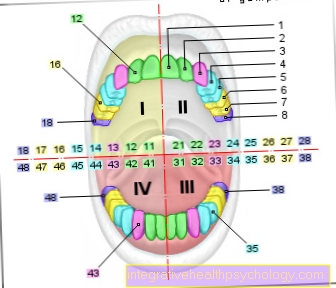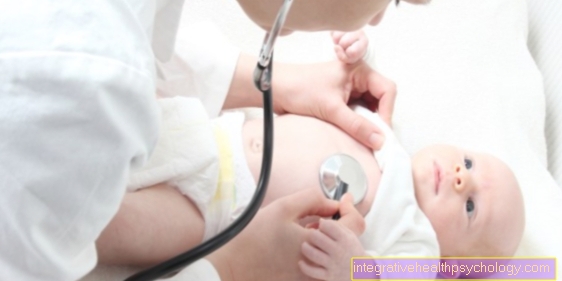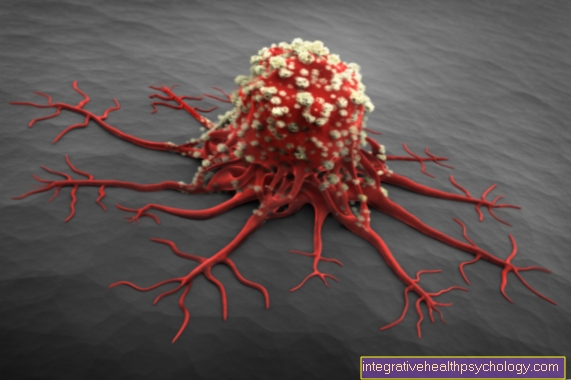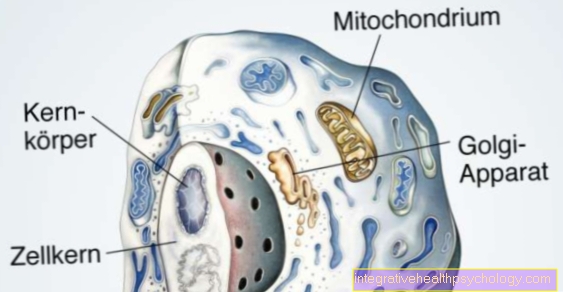Lactose intolerance
Synonyms
Lactose malabsorption, lactose intolerance, lactose intolerance, alactasia, lactose deficiency syndrome
engl .: lactose intolerance
Also read:
- Lactose intolerance diet
- Lactose intolerance symptoms
definition
As Lactose intolerance denotes the deficiency or complete absence of the enzyme Lactase, which is necessary for the correct digestion of the milk sugar contained in milk (Lactose, beta-galactose-1,4-glucose) is required.

Lactose is the main carbohydrate in milk and in various concentrations in cow's milk (4.7g / 100ml) or in breast milk (7g / 100ml) available. Looking at the European population, 5% of the sugar consumed daily is (carbohydrates) Lactose. This is due to the fact that lactose can of course not only be found in milk, but also in numerous products made from milk and also in many finished products.
Epidemiology / frequency distribution
Worldwide are between 80 and 90% of people affected by lactose intolerance. Almost all people south of the Sahara or in China have it Enzyme deficiency. In Germany, the rate of those suffering from lactose intolerance is approximately 15-20 percent.
What are the signs of lactose intolerance?
Lactose intolerance manifests itself through various symptoms.
Classically, these include digestive problems such as flatulence, diarrhea and cramp-like abdominal pain.
Read more about bloated stomach after eating here or Diarrhea after consuming milk - what's behind it?
How severe the complaints are depends on the personal profile of the person concerned. Some people are very sensitive and react with severe discomfort, while others show lighter forms. The amount of lactose consumed also plays a role. The decisive factor here is not only the amount of milk products added, but also the milk sugar content of the product. For example, evaporated milk contains significantly more lactose than normal milk. The proportion of lactose in milk even depends on whether it comes from the cow, goat or sheep.
The symptoms only occur when consuming lactose-containing beverages and foods; if these foods are not consumed, the patient has no symptoms in other health conditions. When the symptoms appear varies, sometimes they appear after 15 minutes or only after hours.
In addition to the typical digestive complaints, there are also other, very unspecific symptoms of lactose intolerance. Those affected describe headaches, dizziness, tiredness, skin changes or depressive moods.
A distinction should be made between lactose intolerance through special diagnostics and milk allergy and through the exclusion principle from so-called irritable bowel syndrome.
Symptoms
More information on the topic: Symptoms of lactose intolerance
Symptoms in adults
Lactose intolerance is characterized by digestive problems after consuming lactose-containing foods and drinks. These include dairy products like milk, cream, yogurt, cream or powdered milk and some types of cheese, especially cream cheeses.
The more lactose, i.e. milk sugar, is consumed, the more serious the symptoms are for those affected.
The ability to use milk can also be partially retained, which results in milder symptoms.
Symptoms of lactose intolerance include:
- cramping abdominal pain
- watery to frothy diarrhea
- Flatulence
Also read: Abdominal cramps and diarrhea
It is common for lactose intolerance to appear in adolescence or adulthood. The reason for this is the loss of the lactase enzyme, which splits milk sugar. In the first few years of life it fulfills its main task, namely to break down lactose from breast milk and make it usable. In purely evolutionary terms, this ability is no longer necessary later.
Therefore, lactose intolerance in adulthood is also very common with 70% of the world population. In Germany the rate is only 15%, as we have got used to consuming dairy products over the course of evolution.
Also read: Diarrhea after consuming milk - what's behind it?
Symptoms in the baby
A congenital lactase deficiency comes total much less often in front as an acquired lactase deficiency.
He makes himself already noticeable in the first weeks of life.
Affected children suffer from severe diarrhea, are malnourished, dried out and seem apathetic. It can too Vomit come.
Read more about the topic here: Diarrhea in the baby
These babies need to be perfect lactose-free baby food received and consistently avoid lactose.
The genetic defect is rare and inherited if it affects both parents themselves.
In premature babies is a temporary Lactose intolerance is not uncommon, there Lactase (which breaks down the sugar and makes it usable) is formed only in the last weeks of pregnancy. Here, lactose-free nutrition is also initially provided. In this case, however, the lactose intolerance is temporary.
Weight gain
An increase in weight is not a symptom a lactose intolerance.
The contrary may however be the case. The affected person eats foods containing lactose that cannot be broken down in the intestine. The sugar is not absorbed and remains in the intestine, where it draws water and it comes to Gas and diarrhea. Because of the water loss the patient loses fluid and weight.
diarrhea
Diarrhea is a possible symptom of lactose intolerance. Especially after consuming lactose-containing foods and beverages, you should be aware of lactose intolerance if diarrhea occurs.
The affected person's stool is very voluminous, watery or foamy.
There are also frequent excretions of stool. The reason for this is that the lactose that cannot be used remains in the intestine. These draw a lot of water, which is then excreted to a greater extent.
Diarrhea is also a symptom of numerous other illnesses. In the consultation with a doctor, it should be discussed whether the occurrence is related to the consumption of certain foods.
Read more about the topic here: diarrhea or Diarrhea after consuming milk - what's behind it?
constipation
Include constipation not necessarily one of the classic symptoms a lactose intolerance. Usually the opposite is the case, namely the occurrence of diarrhea.
However, it can be because of the breakdown of lactose in the colon by bacteria gas arises that the Activity of the bowel slows down. So can a lactose intolerance paradoxically also to constipation to lead.
Find out more about the topic here: Constipation
Flatulence
A classic symptom for lactose intolerance Flatulence after consuming dairy products.
The gas (flatulence in medical terms) occurs by the Breakdown of lactose in the large intestine by bacteriathat are naturally present there.
The resulting gases, especially carbon dioxide and methanecause stomach pain and bad smelling intestinal winds.
Read more about the topic here: Flatulence
heartburn
Classically heard heartburn not to the symptoms a lactose intolerance.
Since every person affected can develop different symptoms and different dimensions, a test for possible lactose intolerance should also be carried out for heartburn without any other cause, especially after consuming dairy products.
Heartburn is actually a Symptom of reflux, the reflux of stomach acid into the esophagus. One reason for this is the consumption of fatty meals. So dairy products can cause heartburn due to their fat content.
You can learn more about the symptom here: heartburn
Diet for people with lactose intolerance
In the case of lactose intolerance, the person affected must contact one if possible low-lactose diet hold on severe symptoms even lactose-free feed.
If you are on a low-lactose diet, you should consume less than 10g of lactose per day.
It should renounces milk and dairy products high in lactose. That includes Whole milk as well as Skimmed milk, condensed milk, heavy cream, whey, cream and yogurt.
The victim should if possible few industrially processed products and take a close look at the lists of ingredients, because milk or milk powder can also be added to inconspicuous products.
Some types of cheese naturally contain one due to their manufacturing process lower proportion of milk sugar, this includes Hard cheeses such as parmesan.
butter is even almost lactose-free.
There are more and more in the grocery trade lactose-reduced products to acquire. There is also the option Lactase in tablet form to take in. This can be helpful if you do not want to eat meals that you have prepared yourself, for example when visiting restaurants or traveling. However, there are many non-standardized preparations on the market that are ineffective or hardly effective in the case of lactose intolerance.
At growing should be noted that by the Refraining from dairy products is a calcium deficiency can occur, here calcium must be supplemented if necessary.
Find out more about the topic here: Diet for people with lactose intolerance
Can you cure lactose intolerance?
Lactose intolerance occurs because some people's bodies lose the ability to break down milk sugar over the course of their lives.
Normally, the lactose is broken down by an enzyme in the wall of the small intestine and so absorbed into the blood.
Since milk was only included in baby food in evolutionary terms, the gene for the enzyme is down-regulated in those affected later in life and is less or no longer active. This natural process is irreversible, one So lactose intolerance cannot be cured.
You can deal with the complaints with a low lactose diet pick up and on a Variety from lactose-free alternatives To fall back on. Meanwhile, restaurants also offer lactose-free dishes, Lactase tablets can help with a calculated intake of dairy products.
prophylaxis
Since the Lactose intolerance is genetically determined, there is no way through certain behavioral or nutrition prevent the occurrence of lactose intolerance.
Diagnosis
Lactose intolerance can often be suspected by taking a thorough medical history of the patient.
Lactose intolerance is particularly likely if abdominal cramps, gas and diarrhea occur after consuming dairy products.
Before other tests are carried out, the patient is trained in a self-experiment on a lactose-free diet. A lactose-free diet should lead to freedom from symptoms. If the symptoms disappear when dairy products are strictly banned from the diet, lactose intolerance is very likely. The patient should, however, be informed exactly how to carry out the low-lactose diet.
If there is a suspicion of primary lactose intolerance, in which the gene for the lactose-splitting enzyme lactase is defective and has never worked, this can be proven by means of a genetic test.
What tests for lactose intolerance are there?
One can be lactose intolerant diagnostic through several tests to back up.:
1. Hydrogen (H2) breath test:
The most commonly used test is H2 breath test.
He is meaningful, not very complex and inexpensive compared to other tests.
Here the patient gets To drink lactose dissolved in water. Then the hydrogen content in the exhaled air is determined by a measuring device. If lactose is not broken down in the small intestine, it is broken down in the large intestine by the natural bacterial flora, creating hydrogen. The Measuring device detects the content of hydrogen in the breathing air, which forms in the case of lactose intolerance after the intake of lactose. The test takes about two to three hours. He will outpatient and does not require any invasive procedures such as blood draw or anesthesia. The patient should, however appear sober, so go without food for 12 hours. He should only drink still water and refrain from smoking and chewing gum.
The lactose supplied can cause the patient Symptoms occur that are typical of lactose intolerance: Abdominal pain, diarrhea, and gas.
The test costs about twenty euros, can also be more expensive due to various fees charged by the center.
2. Lactose tolerance test:
There is also the Lactose tolerance test, in which one drinks approx. 200 ml of a lactose powder dissolved in water. He is, however not very meaningful and is rarely used. Before drinking and every 30 minutes over a period of approx. 2 hours, the blood sugar level (Glucose levels) certainly. Since lactose is split into glucose and galactose in the presence of lactase, if you are not lactose intolerant, the glucose level rises. If the glucose level hardly or not at all increases over a period of two hours, this is a strong indication of lactose intolerance, as lactose cannot be broken down in the small intestine.
3. Small intestine biopsy:
By a Biopsy of the small intestine, i.e. the removal of tissue samples from the wall of the small intestine, the Activity of the milk sugar-splitting enzyme lactase measured become. The test is informative, but complex and associated with risks.
causes

People with Lactose intolerance cannot or only incompletely in lactose Small intestine dismantle. This is because they do not have the enzyme lactase, which breaks down lactose, or only in small quantities. Lactose is a Double sugar (Disaccharide) and therefore has to be two in the body Simple sugars (Monosaccharides) split to ins blood to be included. There are three different causes that can lead to lactose intolerance as a result of lactase deficiency.
A hereditary form of lactase deficiency, the so-called congenital lactase deficiency, is particularly rare. This is differentiated from the others in that those affected do not have the enzyme lactase at all. This means that considerable complications can arise during breastfeeding. The developmental lactase deficiency occurs in premature babies because lactase production only occurs in the last few weeks of the pregnancy in the uterus begins.
The most common cause of lactase deficiency, however, is the primary adult lactase deficiency. This one will recessive inherited, which means that as a child you have to get the gene with the lactase deficiency from both the father and the mother and have not received any of the “healthy” genes, since a “healthy” gene always switches off the gene with lactase deficiency, i.e. opposite it is dominant. This form of lactase deficiency is characterized by the fact that the activity of the lactase enzyme decreases continuously after breastfeeding and comes to a complete standstill by around the age of 20.
In addition to the genetic causes of lactose intolerance, this can also be caused by certain diseases of the small intestine such as Crohn's disease or in diseases of the small intestinal mucosa (Small intestinal mucosa), since there is usually the regulated digestion caused by lactose.
From a biochemical point of view, the cause of lactose intolerance is always the deficiency or complete absence of the enzyme lactase. Lactose is a Double sugar (Disaccharide), which is made up of glucose and galactose linked together. Lactase is the enzyme that breaks this link in the small intestine and enables the body to Glucose and taking galactose into the blood for energy.
If the enzyme lactase is missing, the lactose cannot be broken down in the small intestine. This causes the lactose to enter the Large intestine.
forecast
By Diet change and the intake of lactase supplements can also live well with a lactose intolerance. Sometimes calcium supplements should also be taken so that a change in diet does not lead to too little calcium being supplied to the body.
history
Even if Lactose intolerance is popularly seen as a disease or intolerance, it is now assumed that, due to the very high rate of lactose intolerance sufferers worldwide, the so-called. Wild type of humans, i.e. those with the original gene pool, did not have the ability to produce lactose after Lactation continue to digest. This is also confirmed by the fact that none of the mammals except humans themselves have the enzyme lactase for breaking down lactose after breastfeeding. The ability to digest lactose correctly even after breastfeeding is the result of a gene mutation that has spread because it has proven to be exemplary to enjoy milk without symptoms even after breastfeeding. That is why the prevalence among people with lactose intolerance is particularly low where a lot of milk is consumed even after breastfeeding (e.g. Germany) and especially high in regions (e.g. China) where little to no milk is consumed after breastfeeding.
Summary
Due to a lack of lactase, the lactose cannot be broken down, which leads to characteristic symptoms (Flatulence, diarrhea (Diarrhea) and or stomach pain) leads. Lactose intolerance can be diagnosed with various test methods and its severity, which varies from person to person, can be determined. The recommended therapy is to limit the consumption of lactose-containing products and / or to take lactase supplements to enable the lactose to be properly digested. It is beneficial to seek advice from a professional.






